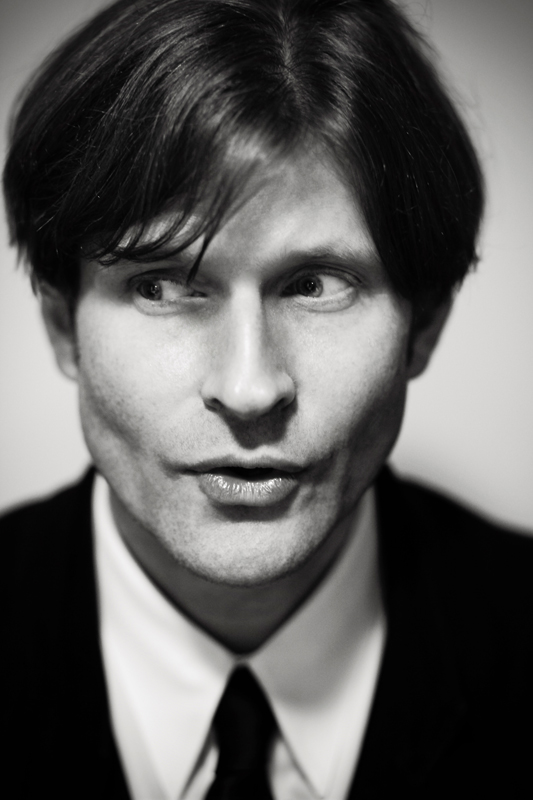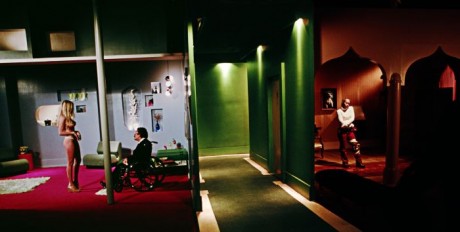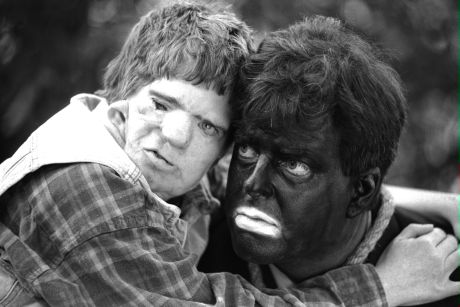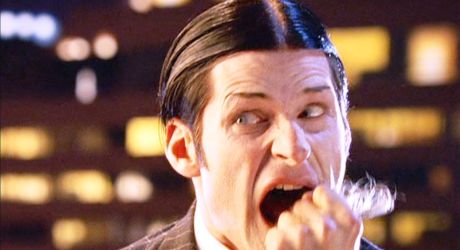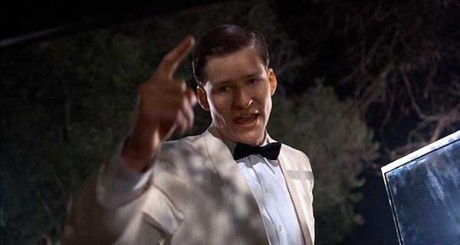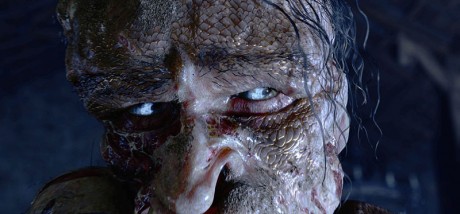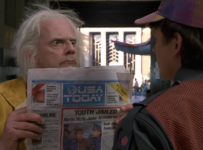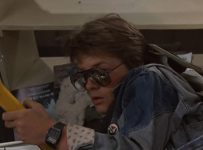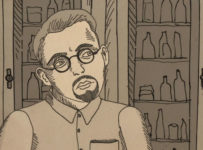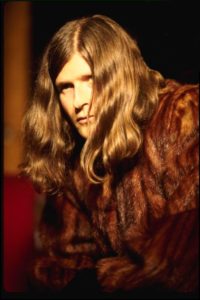 Crispin Glover has worn many hats over the last few decades. Filmmaker, writer and recording artist, he is probably best known to film audiences for his memorable performances in Back to the Future, Willard, Charlie’s Angels and more recently, Alice in Wonderland.
Crispin Glover has worn many hats over the last few decades. Filmmaker, writer and recording artist, he is probably best known to film audiences for his memorable performances in Back to the Future, Willard, Charlie’s Angels and more recently, Alice in Wonderland.
These days, Crispin concentrates on the output from his Volcanic Eruptions production company, through which he publishes books and his films What Is It? and It is fine! EVERYTHING IS FINE! According to his official site, “Crispin celebrates the evident uniqueness and wonder of all individuals and the mystery of the universe. Crispin believes people should think for themselves”.
We need to thank the good people at Perth’s Revelation International Film Festival for arranging this opportunity, and of course, Mr. Crispin Glover for his generous time and wonderful answers.
You can still catch Crispin in Melbourne on July 13 and 14, then in Sydney on July 20 and 21.
Welcome to Australia, and congratulations on the success of your films at the festivals.
Thank you! I am glad to be here and all has gone well at the Revelation Festival.
Your slide shows and travelling shows mix your own personality with literature, images and other elements. What is it about this intertextual relationship that fascinates you?
The live aspects of the shows are not to be underestimated. This is a large part of how I bring audiences in to the theater and a majority of how I recoup is by what is charged for the live show and what I make from selling the books after the shows.
For “Crispin Hellion Glover’s Big Slide Show” I perform a one hour dramatic narration of eight different books I have made over the years. The books are taken from old books from the 1800’s that have been changed in to different books from what they originally were. They are heavily illustrated with original drawings and reworked images and photographs.
I started making my books in 1983 for my own enjoyment without the concept of publishing them. I had always written and drawn and the books came as an accidental outgrowth of that. I was in an acting class in 1982 and down the block was an art gallery that had a book store upstairs. In the book store there was a book for sale that was an old binding taken from the 1800’s and someone had put their art work inside the binding. I thought this was a good idea and set out to do the same thing. I worked a lot with India ink at the time and was using the India ink on the original pages to make various art. I had always liked words in art and left some of the words on one of the pages. I did this again a few pages later and then when I turned the pages I noticed that a story started to naturally form and so I continued with this. When I was finished with the book I was pleased with the results and kept making more of them. I made most of the books in the 80’s and very early 90’s. Some of the books utilize text from the binding it was taken from and some of them are basically completely original text. Sometimes I would find images that I was inspired to create stories for or sometimes it was the binding or sometimes it was portions of the texts that were interesting. Altogether, I made about twenty of them. When I was editing my first feature film “What Is It?” There was a reminiscent quality to the way I worked with the books because as I was expanding the film in to a feature from what was originally going to be a short, I was taking film material that I had shot for a different purpose originally and re-purposed it for a different idea and I was writing and shooting and ultimately editing at the same time. Somehow I was comfortable with this because of similar experiences with making my books.
When I first started publishing the books in 1988 people said I should have book readings. But the book are so heavily illustrated and they way the illustrations are used within the books they help to tell the story so the only way for the books to make sense was to have visually representations of the images. This is why I knew a slide show was necessary. It took a while but in 1992 I started performing what I now call Crispin Hellion Glover’s Big Side Show Part 1. The content of that show has not changed since I first started performing it. But the performance of the show has become more dramatic as opposed to more of a reading. The books do not change but the performance of the show of course varies slightly from show to show based the audience’s energy and my energy.
People sometimes get confused as to what “Crispin Hellion Glover’s Big Slide Show (Parts 1&2)” is so now I always let it be known that it is a one hour dramatic narration of eight different profusely illustrated books that I have made over the years. The illustrations from the books are projected behind me as I perform the show. There is a second slide show now that also has 8 books. Part 2 is performed if I have a show with Part 1 of the “IT” trilogy and then on the subsequent night I will perform the second slide show and Part 2 of the “IT” trilogy. The second slide show has been developed over the last several years and the content has changed as it has been developed, but I am very happy with the content of the second slide show now.
The fact that I tour with the film helps the distribution element. I consider what I am doing to be following in the steps of vaudeville performers. Vaudeville was the main form of entertainment for most of the history of the US. It has only relatively recently stopped being the main source of entertainment, but that does not mean this live element mixed with other media is no longer viable. In fact it is apparent that it is sorely missed.
Still from It is fine! EVERYTHING IS FINE (2007)
I definitely have been aware of the element of utilizing the fact that I am known from work in the corporate media I have done in the last 25 years or so. This is something I rely on for when I go on tour with my films. It lets me go to various places and have the local media cover the fact that I will be performing a one hour live dramatic narration of eight different books which are profusely illustrated and projected as I go through them, then show the film either What Is It? Being 72 minutes or It is fine! EVERYTHING IS FINE being 74 minutes. Then having a Q and A and then a book signing. As I funded the films I knew that this is how I would recoup my investment even if it a slow process.
Volcanic Eruptions was a business I started in Los Angeles in 1988 as Crispin Hellion Glover doing business as Volcanic Eruptions. It was a name to use for my book publishing company. About a year later I had a record/CD come out with a corporation called Restless Records. About when I had sold the same amount of books as CD/records had sold it was very clear to me that because I had published my own books that I had a far greater profit margin. It made me very suspicious of working with corporations as a business model. Financing/Producing my own films is based on the basic business model of my own publishing company. There are benefits and drawbacks about self distributing my own films. In this economy it seems like a touring with the live show and showing the films with a book signing is a very good basic safety net for recouping the monies I have invested in the films.
There are other beneficial aspects of touring with the shows other than monetary elements. There are benefits that I am in control of the distribution and personally supervise the monetary intake of the films that I am touring with. I also control piracy in this way because digital copy of this film is stolen material and highly prosecutable. It is enjoyable to travel and visit places, meet people, perform the shows and have interaction with the audiences and discussions about the films afterwards. The forum after the show is also not to under-estimated as a very important part of the show for the audience. This also makes me much more personally grateful to the individuals who come to my shows as there is no corporate intermediary. The drawbacks are that a significant amount of time and energy to promote and travel and perform the shows. Also the amount of people seeing the films is much smaller than if I were to distribute the films in a more traditional sense.
The way I distribute my films is certainly not traditional in the contemporary sense of film distribution but perhaps is very traditional when looking further back at vaudeville era film distribution. If there are any filmmakers that are able to utilize aspects of what I am doing then that is good. It has taken many years to organically develop what I am doing now as far as my distribution goes.
Still from What Is It? (2005)
Your films seem designed to provoke discussion on taboo issues. Do you think it will ever be possible to have these discussions in a more mainstream context? In addition final instalment of the ‘IT’ trilogy, I believe you are currently building sets for several other projects. What determines the direction of your projects?
Corporate media control waxes and wanes in terms of discussion of taboo and genuine questioning. The last 30 years has had a particular constriction on the kind of discussions that are able to happen in the corporately controlled media. It is possible that constriction could loosen, but that is hard to tell.
I am very careful to make it quite clear that What Is It? is not a film about Down’s Syndrome but my psychological reaction to the corporate restraints that have happened in the last 20 to 30 years in film making. Specifically anything that can possibly make an audience uncomfortable is necessarily excised or the film will not be corporately funded or distributed. This is damaging to the culture because it is the very moment when an audience member sits back in their chair looks up at the screen and thinks to their self “Is this right what I am watching? Is this wrong what I am watching? Should I be here? Should the filmmaker have made this? What is it?” -and that is the title of the film. What is it that is taboo in the culture? What does it mean that taboo has been ubiquitously excised in this culture’s media? What does it mean to the culture when it does not properly process taboo in it’s media? It is a bad thing because when questions are not being asked because these kinds of questions are when people are having a truly educational experience. For the culture to not be able to ask questions leads towards a non educational experience and that is what is happening in this culture. This stupefies this culture and that is of course a bad thing. So What Is It? is a direct reaction to the contents this culture’s media. I would like people to think for themselves.
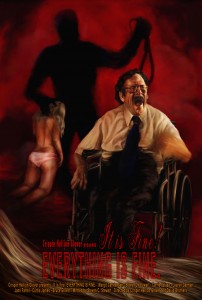 Steven C. Stewart wrote and is the main actor in part two of the trilogy titled It is fine! EVERYTHING IS FINE. I put Steve in to the cast of What Is It? because he had written this screenplay which I read in 1987. When I turned What Is It? from a short film in to a feature I realized there were certain thematic elements in the film that related to what Steven C. Stewart’s screenplay dealt with. Steve had been locked in a nursing home for about ten years when his mother died. He had been born with a severe case of cerebral palsy and he was very difficult to understand. People that were caring for him in the nursing home would derisively call him an “M.R.” short for “Mental Retard”. This is not a nice thing to say to anyone, but Steve was of normal intelligence. When he did get out he wrote his screenplay. Although it is written in the genre of a murder detective thriller truths of his own existence come through much more clearly than if he had written it as a standard autobiography. Steven C. Stewart’s own true story was fascinating and then the beautiful story and the naïve including his fascination of women with long hair and the graphic violence and sexuality and the revealing truth of his psyche from the screenplay were all combined. A specific marriage proposal scene was the scene I remember reading that made me think “I will have to be the person to produce/finance this film.”
Steven C. Stewart wrote and is the main actor in part two of the trilogy titled It is fine! EVERYTHING IS FINE. I put Steve in to the cast of What Is It? because he had written this screenplay which I read in 1987. When I turned What Is It? from a short film in to a feature I realized there were certain thematic elements in the film that related to what Steven C. Stewart’s screenplay dealt with. Steve had been locked in a nursing home for about ten years when his mother died. He had been born with a severe case of cerebral palsy and he was very difficult to understand. People that were caring for him in the nursing home would derisively call him an “M.R.” short for “Mental Retard”. This is not a nice thing to say to anyone, but Steve was of normal intelligence. When he did get out he wrote his screenplay. Although it is written in the genre of a murder detective thriller truths of his own existence come through much more clearly than if he had written it as a standard autobiography. Steven C. Stewart’s own true story was fascinating and then the beautiful story and the naïve including his fascination of women with long hair and the graphic violence and sexuality and the revealing truth of his psyche from the screenplay were all combined. A specific marriage proposal scene was the scene I remember reading that made me think “I will have to be the person to produce/finance this film.”
As I have stated, I put Steven C. Stewart in to What Is It? When I turned What Is It? in to a feature film. Originally What Is It? Was going to be a short film to promote the concept to corporate film funding entities that working with a cast wherein most characters are played by actors with Down’s Syndrome. Steve had written his screenplay in in the late 1970’s. I read it in 1987 and as soon as I had read it I knew I had to produce the film.
Steven C. Stewart died within a month after we finished shooting the film. Cerebral palsy is not generative but Steve was 62 when we shot the film. One of Steve’s lungs had collapsed because he had started choking on his own saliva and he got pneumonia. I specifically started funding my own films with the money I make from the films I act in when Steven C. Stewart’s lung collapsed in the year 2000 this was around the same time that the first Charlie’s Angels film was coming to me. I realized with the money I made from that film I could put straight in to the Steven C. Stewart film. That is exactly what happened. I finished acting in Charlie’s Angels and then went to Salt Lake City where Steven C. Stewart lived. I met with Steve and David Brothers with whom I co-directed the film. I went back to LA and acted in an lower budget film for about five weeks and David Brothers started building the sets. Then I went straight back to Salt Lake and we completed shooting the film within about six months in three separate smaller productions. Then Steve died within a month after we finished shooting. I am relieved to have gotten this film finally completed because ever since I read the screenplay in 1987 I knew I had to produce the film and also produce it correctly. I would not have felt right about myself if we had not gotten Steve’s film made, I would have felt that I had done something wrong and that I had actually done a bad thing if I had not gotten it made. So I am greatly relieved to have completed it especially since I am very pleased with how well the film has turned out. We shot It is fine! EVERYTHING IS FINE. while I was still completing What it? And this is partly why What Is It? took a long time to complete. I am very proud of the film as I am of What Is It? I feel It is fine! EVERYTHING IS FINE. will probably be the best film I will have anything to do with in my entire career. People who are interested in when I will be back should join up on the e-mail list at CrispinGlover.com as they will be emailed with information as to where I will be where with whatever film I tour with. It is by far the best way to know how to see the films.
Crispin Glover as Thin Man in Charlie’s Angels: Full Throttle (2003)
After Charlie’s Angels came out it did very well financially and was good for my acting career. I started getting better roles that also paid better and I could continue using that money to finance my films that I am so truly passionate about. I have been able to divorce myself from the content of the films that I act in and look at acting as a craft that I am helping other filmmakers to accomplish what it is that they want to do. Usually filmmakers have hired me because there is something they have felt would be interesting to accomplish with using me in their film and usually I can try to do something interesting as an actor. If for some reason the director is not truly interested in doing something that I personally find interesting with the character then I can console myself that with the money I am making to be in their production I can help to fund my own films that I am so truly passionate about. Usually though I feel as though I am able to get something across as an actor that I feel good about. It has worked out well.
I admire films and aspire to make films that go beyond the realm of that which is considered good and evil.
I would say that description applies to both “What Is It?” and “It is fine! EVERYTHING IS FINE.” I generally answer with this sort of description of the films when is a moral question about making the films is asked.
Films that are currently financed and distributed by the film corporations and distribution corporations that currently exist must sit within the boundary of that which is considered good and evil. What this means is if there is a so called “bad thing/evil thing” that sits with in a corporately financed and distributed film it must necessarily pointed at by the filmmaker so that the audience is dictated to that the only way to think about that so called “evil thing” is that one way. And to repeat it that one way of thinking about that so called “evil thing” is only that, “evil”. Any other way of think about that so called “evil thing” would be considered wrong and it must be made in such a way that they audience understands that the filmmakers feel that this “evil thing” is only that and no other way of thinking about that “evil thing” could or should be possible. A film that goes beyond the realm of good and evil may have this same so called “evil thing” but the filmmaker may not necessarily point at that so called “evil thing” so that the audience are not dictated to and therefore can determine and think what for itself as to what this so called “evil thing” really is to them.
I should not go in to detail for “IT IS MINE.” yet and I will not shoot that next. There are other projects outside of the trilogy that I will shoot next. The Czech Republic is another culture and another language and I need to build up to complex productions like “What is it?” and the existing sequel “It is fine! EVERYTHING IS FINE.” IT IS MINE. Is an even more complex project than those two films were so it will be a while yet for that production. I will step outside of the trilogy for a number of films that deal with different thematic elements.
The sets for my next film productions have started construction. The next production will not be part of the “IT” trilogy. I have been working on the themes that are part of that trilogy for many years so I am looking forward to stepping outside of those themes in my next productions. At the same time the sets are being built I am in the process of continuing to develop the screenplay for myself and my father to act in together on these very sets. He is also an actor and that is the next film I am planning to make as a director/producer. This will be the first role I write for myself to act in that will be written as an acting role as opposed to a role that was written for the character I play to merely serve the structure. But even still on some level I am writing the screenplay to be something that I can afford to make. There are two other projects I am currently developing to shoot on sets at my property in the Czech Republic. The cost of the set building will determine which one I actually shoot next. I am not concerned whether my next films will ultimately be distributed in the way I have been self distributing my films or if I will sell them to be corporately distributed. It could be at some point that my films will be corporately distributed. I am not against corporate distribution I am only against the constrictions that tend to happen when people are specifically making films to be corporately distributed. It seems plausible that my own film making may coincidentally align to the interests of corporate distribution and if that should happen and it makes a mathematical sense to sell to distribution company then I would do it. I that did not happen and I continue to self distribute in the way I am that would be ok as well. The most important aspect is to make my own films that I am passionate about.
Crispin Glover as George McFly in Back to the Future (1985)
A number of your characters have been outsiders in some way, everything from George McFly to Rubin Farr and of course, Willard. What attracts you to these roles, and what do you look for in a character?
In the last decade I have been specifically funding my films with the money I make as an actor. So I almost think of the roles I am offered as acting assignments. I mean that in a positive way and I am grateful to get those assignments.
Usually what I’m trying to do is to find the psychological truth of the characters I’m playing. Perhaps “outsiderness” is present but it usually manifests from what seems appropriate for the psychology of the character.
I do not try to and I never have tried to make a perception of being an outsider in the corporately funded and distributed film world. I don’t feel like an outsider in the corporately funded and distributed film world. I understand why there is the perception of me being an outsider but it is not a perception I am attempting to have.
I see myself as someone who has been raised with the understanding of how corporately funded and distributed film business works. I have had a certain amount of acceptance within that business. While I am grateful to that system to have made a living in it for about thirty-five years I have also had a certain amount of question about how to make the corporately funded and distributed film business more truly educational. There may be reasons why the corporately funded and distributed film business does not want to be truly educational and anyone who does that may be questioned back in multiple ways.
Within the corporately funded and distributed film world I see myself as an actor for hire and am grateful to that system to have made a living in it for about thirty five years.
You’ve recently shot your scenes for the thriller Motel. Was there a challenge you wished to pursue in this role?
This role was fun to play and the dialogue was well written. I am looking forward to seeing the film.
Crispin Glover motion captured Grendel in Beowulf (2007)
From an actor’s point of view, is there a difference to a traditionally filmed performance and motion capture? Has making your own films informed or changed your approach to acting and your other artistic endeavours?
The technology for Beowulf is different from standard animation. The motion capture technology used for Beowulf is an excellent technology for acting as all actors are surrounded 260 cameras so every actor is in a simultaneous wide shot and close up so the actors do not have to do off camera acting and it makes for excellent performances to play off of on every take. I would definitely work in that technology again if it was offered to me. When working on Tim Burton’s Alice in Wonderland there was more green screen technology used and very little motion capture that was a different sort of technology from what was used on Beowulf.
Acting in front of a camera does help quite a lot behind the camera particularly if one has been studying what everyone does on the set while one is acting. But I would also say an extremely valuable thing is to physically edit one’s own film which I did for What Is It? This is extremely valuable for knowing what is actually necessary to shoot and what is helpful and not. That in turn is also good for acting. Particularly giving variation in performance for an editor.
You have said that your filmmaking is the most important thing to you. What advice would you give to people trying to break into the industry?
I liked what two of my favourite filmmakers answered when asked “How do you become a film director?” Stanley Kubrick answered “By directing films.” Werner Herzog answered something to the affect of “Steal a camera.” Even though they are seemingly different answers to me they are virtually the same. What it means is you must manifest directing films. There is no other way. It seemly is something that must be and you will make it happen. That is all.

